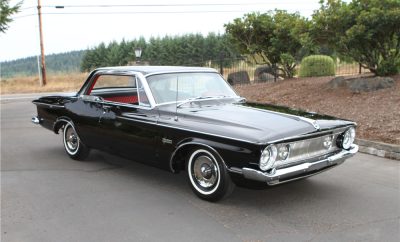
For many car enthusiasts, the question of what was the first muscle car ever created divides opinion, and it is often argued that it was the 1964 Pontiac GTO that truly kicked off the era. However, two years prior to this, the 1962 Plymouth Fury Max Wedge had already been built, with a larger engine, higher horsepower and a three-speed TorqueFlite automatic transmission – so why does the answer for the era’s starting point rarely seem to include this car?
The styling for the 1962 Plymouth Fury Max Wedge looked to be a transitional step between the 1950s designs and the later 1960s models, and Elwood Engel’s efforts can be seen all over the car. The infamous Pontiac GTO of 1964 had a base price of around $2,491 – the Plymouth Fury Max Wedge in contrast cost $3,308. Despite the power and quality of the Max Wedge, just 298 cars were built (all models) in comparison to Pontiac’s 32,540 – over 100 times more. As such, it seems that the popularity of the GTO gave it an far bigger spotlight to be seen as the original template.
The Max Wedge formula actually began back in 1958, when Chrysler’s powertrain planning team developed the lightweight “B” series V8 big-block with a wedge-shaped combustion chamber, used in engine sizes of both 350 and 361 cubic inches. This provided the necessary quench area for improved performance, and the ‘RB’ version was released in 1959, with the 413ci RB-series engine eventually finding its way into the original Max Wedge cars. With its specification of a 410/420 horsepower engine, these cars were only available for use in competitions, and many argue that this is why the GTO has been widely considered as the first muscle car.
It is also worth noting that the Max Wedge included a three-speed TorqueFlite automatic transmission, which offered flawless shifting. GM would not get the TH400 until 1965, and Ford would not get its own three-speed automatic until 1966 – highlighting that Chrysler had a complete transmission dominance for three years. The development of the Max Wedge continued in 1964 with the 426ci engine, but it was suspended when the Hemi engine began production.
The platforms for chassis and engine combinations like the Max Wedge and GTO began on body-on-frame designs from Chrysler (Plymouth and Dodge) and Ford (Fairlane). And though the availability time period was different, the fundamental idea of putting large-displacement engines into lightweight production vehicles remained the same. This gave rise to performance-grade road cars where drivers could feel the power of the engine, and the chases we now associate with muscle cars began.
The Max Wedge continued to be a successful platform in 1964. Although the 426ci engine was discontinued in mid-1964, the Max Wedge still remained incredibly powerful. In fact, the Max Wedge engine held the record for power output from an American production engine until the introduction of the legendary 426 Hemi in 1966.
The Max Wedge was also a pioneer in terms of race-spec performance parts. Chrysler offered lightweight aluminium parts for their stock Max Wedge cars, including special valve covers, intake and exhaust manifolds. These parts, combined with the high-compression heads and dual four-barrel carburettors, helped to make the Max Wedge one of the most powerful production cars at the time.
The debate about the importance of the Pontiac GTO or the Max Wedge will probably never end. But it should be noted that the Max Wedge’s influence is still widely felt today in the higher valuations and the nostalgia that goes along with it. So while the Pontiac might have been a commercial success, the heavily-modified Max Wedge cars stand as a testament to the beginnings of the muscle car era. Tune in to MotorTrend TV and MotorTrend+ to find out more about Max Wedge and other classic vehicles.
VN:F [1.9.22_1171]
VN:F [1.9.22_1171]


